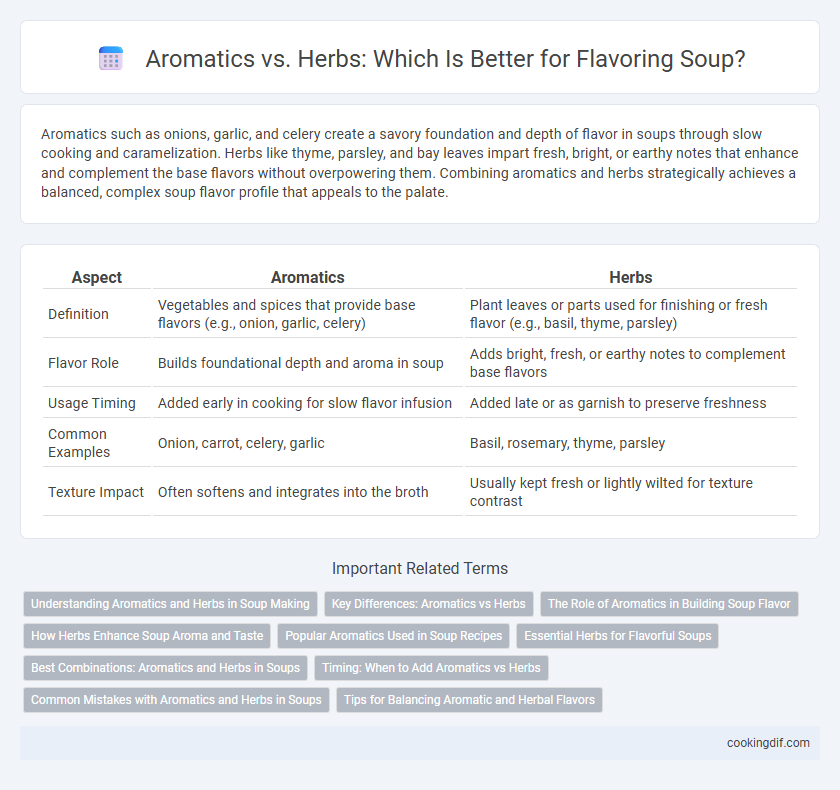Aromatics such as onions, garlic, and celery create a savory foundation and depth of flavor in soups through slow cooking and caramelization. Herbs like thyme, parsley, and bay leaves impart fresh, bright, or earthy notes that enhance and complement the base flavors without overpowering them. Combining aromatics and herbs strategically achieves a balanced, complex soup flavor profile that appeals to the palate.
Table of Comparison
| Aspect | Aromatics | Herbs |
|---|---|---|
| Definition | Vegetables and spices that provide base flavors (e.g., onion, garlic, celery) | Plant leaves or parts used for finishing or fresh flavor (e.g., basil, thyme, parsley) |
| Flavor Role | Builds foundational depth and aroma in soup | Adds bright, fresh, or earthy notes to complement base flavors |
| Usage Timing | Added early in cooking for slow flavor infusion | Added late or as garnish to preserve freshness |
| Common Examples | Onion, carrot, celery, garlic | Basil, rosemary, thyme, parsley |
| Texture Impact | Often softens and integrates into the broth | Usually kept fresh or lightly wilted for texture contrast |
Understanding Aromatics and Herbs in Soup Making
Aromatics such as onions, garlic, celery, and carrots create the foundational flavors in soup by releasing essential oils and enhancing taste during the cooking process. Herbs, including thyme, parsley, bay leaves, and rosemary, add distinct, layered notes that develop complexity and complement the base flavors established by aromatics. Combining both aromatics and herbs strategically results in a well-balanced, richly flavored soup.
Key Differences: Aromatics vs Herbs
Aromatics, such as onions, garlic, and celery, form the flavor base of soups by releasing essential oils when sauteed, creating depth and complexity. Herbs, like thyme, parsley, and basil, are primarily used to enhance and finish the soup with fresh, vibrant notes either during cooking or as a garnish. The key difference lies in their usage: aromatics build the foundational flavor early in the cooking process, while herbs add distinct seasoning and aroma typically toward the end.
The Role of Aromatics in Building Soup Flavor
Aromatics such as onions, garlic, celery, and carrots play a foundational role in building soup flavor by releasing essential oils and deepening the overall taste profile during the cooking process. These ingredients create a savory base known as mirepoix, which enhances both aroma and complexity, setting the stage for richer, more balanced soups. Herbs complement aromatics by adding fresh, layered notes, but it is the slow sauteing of aromatics that intensifies soup umami and warmth.
How Herbs Enhance Soup Aroma and Taste
Herbs like thyme, rosemary, and basil enhance soup aroma by releasing essential oils that infuse depth and complexity into the broth. These fresh or dried herbs contribute vibrant, layered flavors that complement and elevate the primary ingredients without overpowering them. Incorporating herbs at different cooking stages maximizes their impact, resulting in a richly aromatic and flavorful soup.
Popular Aromatics Used in Soup Recipes
Popular aromatics like onions, garlic, carrots, and celery form the foundational flavor base in many soup recipes, providing depth and richness. These ingredients release essential oils and sugars that enhance the overall taste profile during the cooking process. Unlike herbs, which are often added at the end for freshness, aromatics are typically sauteed or simmered to build a savory and aromatic broth.
Essential Herbs for Flavorful Soups
Essential herbs like thyme, bay leaves, and parsley are key for developing rich, layered flavors in soups, offering fresh, earthy, and slightly minty notes. Aromatics such as onions, garlic, and celery provide a robust flavor base but are best complemented by herbs to elevate the overall taste complexity. Incorporating essential herbs at the right stage enhances the soup's aroma and depth, making each spoonful intensely savory and vibrant.
Best Combinations: Aromatics and Herbs in Soups
Aromatics like onions, garlic, and celery create a rich flavor base while herbs such as thyme, parsley, and bay leaves add depth and freshness to soups. Combining aromatics with complementary herbs enhances the soup's complexity, for example, pairing rosemary with garlic or dill with onions elevates the overall taste profile. Using fresh herbs near the end of cooking preserves their brightness, while aromatics benefit from slower cooking to release their essential flavors fully.
Timing: When to Add Aromatics vs Herbs
Aromatics like onions, garlic, and celery release their flavors best when sauteed at the beginning of soup preparation, allowing their essential oils to infuse the broth deeply. Herbs such as thyme, parsley, and basil should be added later in the cooking process or just before serving to preserve their bright, fresh flavors and aromatic oils. Timing these additions properly ensures a balanced, layered taste that enhances the soup's overall complexity.
Common Mistakes with Aromatics and Herbs in Soups
A common mistake with aromatics in soups is overcooking them, which can lead to a dull or bitter flavor, rather than enhancing the broth's depth. Another error is adding fresh herbs too early in the cooking process, causing their delicate flavors to dissipate and lose vibrancy. Using the right balance of aromatics like onions, garlic, and celery alongside fresh herbs such as thyme and parsley ensures a well-rounded and flavorful soup.
Tips for Balancing Aromatic and Herbal Flavors
Balancing aromatic and herbal flavors in soup requires using aromatics like onions, garlic, and celery as a flavorful base while incorporating fresh herbs such as thyme, parsley, or basil towards the end of cooking to preserve their brightness. Adjust the quantity of aromatics to enhance the soup's depth without overpowering, and add herbs gradually to achieve a harmonious taste profile. Taste frequently and adjust seasoning with salt and acid to complement both aromatic and herbal elements effectively.
Aromatics vs Herbs for flavoring Infographic

 cookingdif.com
cookingdif.com